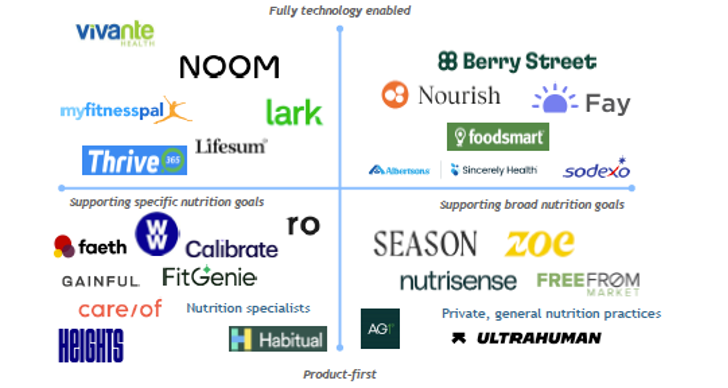It's Getting Easier to Eat Your Veggies
My foray into nutrition support and why it's starting to look so similar to teletherapy
Last spring, in a very-Kiera way, I went down a rabbit hole into the telehealth-based nutrition support space. I studied the market, narrowed down the players to the top three (Nourish, Berry Street, and Fay Nutrition), and then booked calls with all of them to get some nutrition advice, see what these platforms felt like, and what their differences were. I did so more out of curiosity than need. I am a member of the “worried well” – health-conscious consumers who seek preventative healthcare less because they acutely need it and more because, well, you can never stop improving.
Recently, I’ve watched the nutrition space get a lot of love. Americans were overweight and now fewer of them are overweight, largely due to a magic drug (GLP-1s) that increases insulin production, reduces glucagon, and squashes your appetite. While GLP-1s feel novel, it is in public discourse only. Discovered in the 1970s, the first GLP-1 received FDA approval in April 2005, originally for diabetes patients who used it for managing their blood sugar. When it became apparent that GLP-1s also had widespread weight loss capabilities, that’s when you probably started hearing about them. Take a second look at anyone you know who has had a miracle-like weight-loss transformation in the past few years. Chances are it wasn’t all because of a leafy diet and the treadmill. Just ask Oprah.
Beyond GLP-1s, nutrition support is getting a much-needed makeover. Gone are the days of the (now disproven) food pyramid and elusive nutritionists hanging out in unmarked offices. And in its place is a technologically-enabled reinvention of the nutrition industry into something that is widely accessible, easy to understand, and far more effective.
Nutrition is arguably the largest health issue for Americans today. 50% of Americans have a poor-quality diet and 60% of American adults have a chronic illness that could benefit from nutrition care. Poor diet is the leading risk factor for death in the US and the greatest driver of healthcare spending. $50B of total US healthcare spend goes towards combatting nutrition-related ailments. Improving nutritional care in America will not only greatly bring down healthcare costs but can also be the single greatest catalyst for expanding the American lifespan.
Because it’s heavily habits-based, nutrition has historically been a hard thing to support through our traditional healthcare infrastructure which prioritizes acute care over preventative health. Due to technology, this is all changing.
The best comparison to the nutrition support market in 2024 is the mental health support market in ~2020. Like with mental health, successfully supporting nutrition outcomes takes constant communication between a patient and provider. Also like mental health, nutritional care providers historically consist of individual, mom-and-pop-style private practices that are hard for patients to find, assess, and then predict the cost of. Pricing for nutrition care is made more complex due to the range of certifications nutrition providers have. There are many in the nutrition space marketing themselves as “nutritionists” and “dieticians” but only those who are "Registered Dieticians" and "Registered Dietician Nutritionists" will be insurance covered. Knowing this and making this distinction as a patient is difficult.
Mental health support was transformed by technology. Teletherapy companies like Lyra and BetterHelp popped up to aggregate these small practices onto one easy-to-navigate platform, made pricing transparent, supported insurance coverage for care, and also built digital tools to allow providers and patients to keep in better touch. Now, the same thing is happening with nutrition. Companies like Fay Nutrition, Berry Street, and Nourish are doing the same in the nutrition space. They offer databases of nutritionists, guarantee insurance coverage for care, and work with platforms like Healthie (founded by the formidable duo Erica Jain and, my amazing brother,
) to maintain constant communication with their patients.The result is a win-win-win for providers, patients, and payers. The providers get to reduce their burdens by reaping the benefits of what
‘s Brian O’Malley might call a “digitally-native franchise” model — joining a scaled, business platform with a built-in network and administrative support. The patients can quickly navigate and get care that works. And the payers save money because better nutrition support means fewer Americans with poor diets, which drives down rates of chronic illnesses and other expensive healthcare costs.GLP-1s are getting all the media love now because their impact is instant and guaranteed but soon, the 9 million GLP-1 users, tired of side effects and overwhelmed by the cost, will find their way to platforms like Nourish, seeking sustainable solutions to America’s largest health problem.







Hi! Any chance you have a review or perspective on your comparison of Fay vs Berry vs Nourish?